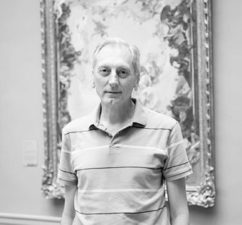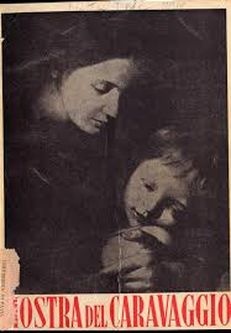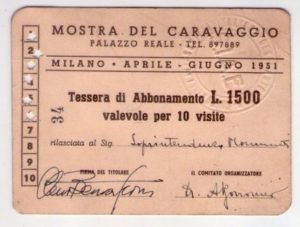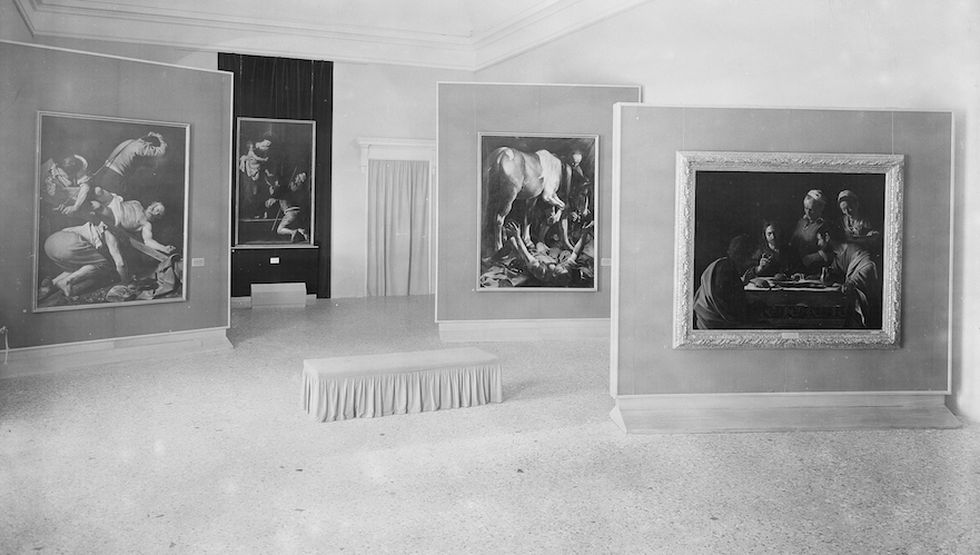di Keith CHRISTIANSEN
 Il saggio di Luca Bortolotti dell’ultimo numero di About Art, oltre ad avere avuto numerosissimi lettori (più di 1500 nei primi quattro giorni !) ha dato luogo ad una serie di commenti (tutti piuttosto positivi, dobbiamo rilevare) di addetti ai lavori e studiosi del ‘caravaggismo’, tanto da indurci ad aprire un dibattito su un tema che da tempo in effetti è oggetto della attenzione e delle riflessioni tanto degli esperti quanto degli interessati – sempre numerosissimi- alla figura e all’opera di Michelangelo Merisi. Riceviamo e pubblichiamo con grande piacere per primo il contributo di Keith Christiansen che del genio lombardo è attentissimo studioso da molto tempo; la figura e l’opera del Prof. Christiansen è troppo nota per spendere anche due sole parole di presentazione, basterà dire che -oltre alle varie cariche ricoperte nel corso degli anni- è stato fino a poco tempo fa il Direttore del Department of European Paintings al Metropoklitan Museum of Art di New York; delle numerose pubblicazioni è impossibile dar conto in questa sede.
Il saggio di Luca Bortolotti dell’ultimo numero di About Art, oltre ad avere avuto numerosissimi lettori (più di 1500 nei primi quattro giorni !) ha dato luogo ad una serie di commenti (tutti piuttosto positivi, dobbiamo rilevare) di addetti ai lavori e studiosi del ‘caravaggismo’, tanto da indurci ad aprire un dibattito su un tema che da tempo in effetti è oggetto della attenzione e delle riflessioni tanto degli esperti quanto degli interessati – sempre numerosissimi- alla figura e all’opera di Michelangelo Merisi. Riceviamo e pubblichiamo con grande piacere per primo il contributo di Keith Christiansen che del genio lombardo è attentissimo studioso da molto tempo; la figura e l’opera del Prof. Christiansen è troppo nota per spendere anche due sole parole di presentazione, basterà dire che -oltre alle varie cariche ricoperte nel corso degli anni- è stato fino a poco tempo fa il Direttore del Department of European Paintings al Metropoklitan Museum of Art di New York; delle numerose pubblicazioni è impossibile dar conto in questa sede.
Caro Direttore
Thanks for this ( cfr https://www.aboutartonline.com/caravaggismo-malattia-infantile-dello-specialismo-cosa-ce-dietro-la-caravaggio-mania-e-le-sue-conseguenze/.)
 You might recall that Berenson, in responding to the great Milan exhibition of Caravaggio that first put him before the public’s eye, noted that his biography more than his work accounted for his fame. Although easy to dimiss, I believe that a great deal of the current obsession with Caravaggio has to do with that biography. Gays see him as a champion. People who have a hard time “fitting in” associate him with their problems. He is the anti-establishment figure. And someone with a criminal record to boot. Think, for a moment, about the way Artemisia has been transformed from a talented but hardly transformative artist into a proto-feminist and victim. Her father’s art—an art that exists on more consistently high level—has been overshadowed by hers. I remember Charles Dempsey remarking to me that he would never have believed that Orazio would be overshadowed by his daughter. So, I think the artist’s biography has an awful lot to do with it, which is why there are popular biographies about Caravaggio.
You might recall that Berenson, in responding to the great Milan exhibition of Caravaggio that first put him before the public’s eye, noted that his biography more than his work accounted for his fame. Although easy to dimiss, I believe that a great deal of the current obsession with Caravaggio has to do with that biography. Gays see him as a champion. People who have a hard time “fitting in” associate him with their problems. He is the anti-establishment figure. And someone with a criminal record to boot. Think, for a moment, about the way Artemisia has been transformed from a talented but hardly transformative artist into a proto-feminist and victim. Her father’s art—an art that exists on more consistently high level—has been overshadowed by hers. I remember Charles Dempsey remarking to me that he would never have believed that Orazio would be overshadowed by his daughter. So, I think the artist’s biography has an awful lot to do with it, which is why there are popular biographies about Caravaggio.
Then, look at Roger Fry’s damning essay on baroque painting and you will find the analogies of Caravaggio’s art with movies. A second reason. I would add that the rise of photography as completely transformed the way young people look at art. There is no place for the idealist vocabulary of Raphael and Annibale Carracci. That actually requires buying into the idea of hierarchies as well as the refined world of antiquarianism. And that is the culture that sustained those artists in the 18th and 19th centuries. The revolution in populist culture has no space for their art—which is why it will be interesting to see the demographics of visitors during in the Raphael year. My guess is that it will be an older generation.
We live in a celebrity culture, and Caravaggio has become a celebrity. But that does not mean that there is an equal interest in his gifted followers. Ribera commands no such following. Yet he is arguably the greater painter. When I organized the exhibition on Valentin together with Annick Lemoine, it was out of the conviction that, like Ribera, Valentin took Caravaggio’s innovations to the next stage. What? Caravaggio establish the groundwork for something “beyond” what he did? YES. But even students of the period are not much interested in that.
 Finally: it’s time scholars began to deal with the question of the degree to which the caravaggesque revolution had social rather than purely artistic implications. The market, which was the means by which Caravaggio established himself in Rome and something he remained invested in to the end of his career, was transformative. It was anti-hierachical and could not be controlled by the Accademia. It was the means by which both Ribera and Valentin created careers and explored new subjects. The seventeenth century is fascinating precisely because alongside the conventional manner of training and securing patronage there was a new, far less predictable market with dealers. It was the market that encouraged the creation of new genres and through which many more artists gained a voice outside the official sanctions of the academies, which can be seen as a conservative and even regressive movement that, under the guise of raising the status of the artist actually closed off innovation and experimentation—until in the 19th c. it met with a head-on attack.
Finally: it’s time scholars began to deal with the question of the degree to which the caravaggesque revolution had social rather than purely artistic implications. The market, which was the means by which Caravaggio established himself in Rome and something he remained invested in to the end of his career, was transformative. It was anti-hierachical and could not be controlled by the Accademia. It was the means by which both Ribera and Valentin created careers and explored new subjects. The seventeenth century is fascinating precisely because alongside the conventional manner of training and securing patronage there was a new, far less predictable market with dealers. It was the market that encouraged the creation of new genres and through which many more artists gained a voice outside the official sanctions of the academies, which can be seen as a conservative and even regressive movement that, under the guise of raising the status of the artist actually closed off innovation and experimentation—until in the 19th c. it met with a head-on attack.
Keith CHRISTIANSEN September 2019
John Pope-Hennessy Chairman
European Paintings
212 650 2414
———————————————- ——————————————————- ————————
Italian translation
Dovresti ricordare che Berenson, nel replicare alla grande mostra milanese su Caravaggio, che per la prima volta mise l’artista sotto gli occhi del grande pubblico, notò che a rappresentare la sua fama fosse più la sua biografia che il suo lavoro. Sebbene sia facile da rimuovere, credo che gran parte dell’attuale ossessione per Caravaggio abbia a che fare con quella biografia. I gay lo vedono come un campione. Le persone che hanno difficoltà ad “adattarsi” lo associano ai loro problemi. È la tipica figura anti-establishment. E qualcuno con precedenti penali da avviare. Pensiamo, per un momento, al modo in cui Artemisia è stata trasformata da artista di talento ma non propriamente rivoluzionaria com artista in proto-femminista e vittima. L’arte di suo padre – un’arte che esiste a un livello sempre più elevato – è stata oscurata dalla sua. Ricordo che Charles Dempsey mi disse che non avrebbe mai creduto che Orazio sarebbe stato messo in ombra da sua figlia. Quindi, penso che la biografia dell’artista abbia molto a che fare con questo, motivo per cui ci sono biografie popolari su Caravaggio.
Dunque, guarda il saggio di Roger Fry sulla pittura barocca e troverai le analogie dell’arte di Caravaggio con i film. Un secondo motivo. Aggiungerei che l’ascesa della fotografia ha completamente trasformato il modo in cui i giovani guardano l’arte. Non c’è posto per il vocabolario idealista di Raffaello e Annibale Carracci. Questo in realtà richiede di entrare nell’idea delle gerarchie tanto quanto nel raffinato mondo dell’antiquariato. E questa è la cultura che ha sostenuto quegli artisti nei secoli XVIII e XIX. La rivoluzione nella cultura populista non ha spazio per la loro arte, motivo per cui sarà interessante vedere la tipologia dei visitatori durante l’anno di Raffaello. La mia ipotesi è che sarà una generazione piuttosto anziana.
Viviamo in una cultura di celebrità e Caravaggio è diventato una celebrità.
Ma ciò non significa che vi sia un uguale interesse nei suoi seguaci di talento. Ribera non ne è alla testa, eppure probabilmente è il pittore più grande. Quando ho organizzato la mostra su Valentin insieme ad Annick Lemoine, ero convinto che, come Ribera, Valentin portasse ad una fase più avanzata le innovazioni di Caravaggio. Cioè che Caravaggio stabilisce le basi per qualcosa di “oltre” rispetto quello che ha fatto? SÌ. Ma perfino gli studenti del periodo non sono molto interessati a questo.
Infine: è tempo che gli studiosi inizino ad affrontare la questione del grado in cui la rivoluzione caravaggesca ha avuto implicazioni sociali piuttosto che puramente artistiche. Il mercato, che era il mezzo con cui Caravaggio si è stabilizzato a Roma e in cui rimase invischiato fino alla fine della sua carriera, e comunque fu un rivoluzionario. Egli era contro le gerarchie e non poteva essere controllato dall’Accademia. Fu il mezzo con cui sia Ribera che Valentin crearono carriere e esplorarono nuovi argomenti. Il diciassettesimo secolo è affascinante proprio perché accanto al modo convenzionale di addestramento e protezione del patrocinio c’era un mercato nuovo, molto meno prevedibile con i rivenditori. È stato il mercato che ha incoraggiato la creazione di nuovi generi e attraverso il quale molti più artisti poterono avere voce anche al di fuori delle dichiarazioni ufficiali delle accademie; questo può essere visto come un qualcosa di conservatore e persino di regressivo che, con il pretesto di elvare lo status dell’artista, in realtà ha chiuso l’innovazione e la speranza fino al XIX secolo, ha incontrato un attacco frontale.
Keith CHRISTIANSEN
John Pope-Hennessy Chairman
European Paintings
212 650 2414

